Oh my, it’s July: Summer sweet and deep
Frontenac State Park Association newsletter
July 2025 (Vol. 3, No. 7)
Comments, contributions, compliments, complaints? Reach your newsletter editor at pamelamarianmiller@gmail.com.
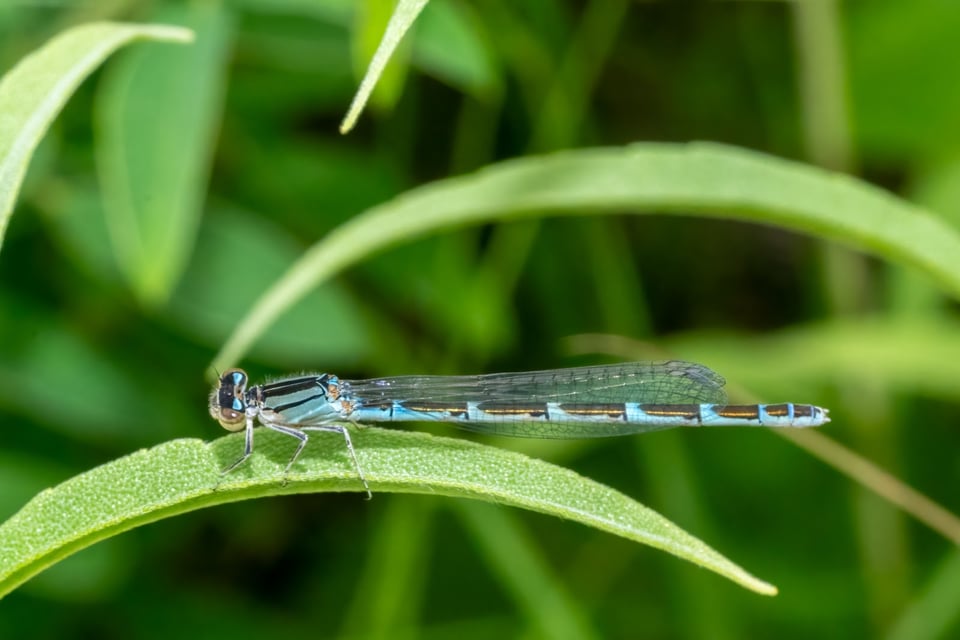
Oh my, it’s July: Summer sweet and deep
“Summer afternoon — summer afternoon; to me those have always been the two most beautiful words in the English language.” So wrote the great American novelist Henry James, who, despite all the complications that American life brought him (and us) knew what was what.
It’s the heart of summer, fierce and fleeting. Don’t let July race past without reveling in it. On its loveliest days, head to Frontenac State Park to see what you can see, feel what you can feel.
We, your pals in the Frontenac State Park Association, will also be there, saluting you on trails and leading events and walks for you and your families. From our calendar to yours:
Tuesday, July 1, 10-11 a.m.: Nature Explorers class on rocks for preschoolers. Join instructor Sara Holger of Project Get Outdoors and FSPA volunteers for a merry hour of fun and learning at and outside the main picnic shelter. Children must be accompanied by an adult.
Saturday, July 5, 10-11 a.m.: Guided nature walk with Bruce Ause. Meet at the campground kiosk for a nature walk with interpretive naturalist Bruce Ause. Bruce’s walks are by far the most popular organized activity in the park. Come see why!
Saturday, July 12, 9-11 a.m.: Guided bird walk in campground area with Janet Malotky and Steve Dietz. Meet at the campground shower building for a walk through a mixed habitat of prairie and woodland looking for nesting birds that specialize in these areas, including Baltimore Orioles and perhaps some Orchard Orioles, Eastern Bluebirds, Clay-colored Sparrows and up to six species of woodpeckers. The trail is well-maintained mowed grass. Bring your binoculars or borrow some from the park office. Questions? Email janetmalotky@gmail.com.
Saturday, July 12, 10-11 a.m.: Guided nature walk with Bruce Ause. Meet at the campground kiosk for a nature walk with interpretive naturalist Bruce Ause.
Saturday, July 19, 10-11 a.m.: Guided nature walk with Bruce Ause. Meet at the campground kiosk for a nature walk with interpretive naturalist Bruce Ause.
Saturday, July 26, 10-11 a.m.: Guided nature walk with Bruce Ause. Meet at the campground kiosk for a nature walk with interpretive naturalist Bruce Ause.
Saturday, July 26, 11 a.m.-12:30 p.m. Guided fungi walk with Pam Miller. We’ll walk along an unscouted park firebreak trail, talk about the science of fungi, and hope to find midsummer edibles such as chanterelles and chicken of the woods, but no guarantees! Guaranteed: An interesting walk! Meet at the campground kiosk. Wear closed shoes and long pants and bring bug spray. Questions? Email pamelamarianmiller@gmail.com.
Saturday, July 26, 8:30 p.m.-11:45 p.m.: “Starry, Starry Nights” program with the Rochester Astronomy Club, main picnic shelter/upper parking lot. Those of you who have attended these before know how magical they are. We start with a short informational program in the picnic shelter, then move outside as darkness falls to watch the skies through amazing telescopes provided by Rochester Astronomy Club members, who also are great at describing what we’re seeing. Especially exciting for kids interested in science. More information can be found here. If the weather looks iffy, call ahead to confirm: 651-299-3000.
Saturday, Aug. 2, 9-11 a.m.: Guided walk on post-fire ecology with head ranger Jake Gaster. Meet at park headquarters.
Saturday, Aug. 2, 10-11 a.m.: Guided nature walk with Bruce Ause. Meet at the campground kiosk for a nature walk with interpretive naturalist Bruce Ause.
Tuesday, Aug. 5, 10-11 a.m.: Nature Explorers for preschoolers with interpretive naturalist Sara Holger. Make a walking stick! Meet at the main park headquarters.
Saturday, Aug. 9, 10-11 a.m.: Guided nature walk with Bruce Ause. Meet at the campground kiosk for a nature walk with interpretive naturalist Bruce Ause.
Saturday, Aug. 16, 10-11 a.m.: Guided nature walk with Bruce Ause. Meet at the campground kiosk for a nature walk with interpretive naturalist Bruce Ause.
Thursday, Aug. 21, 3-4:30 p.m.: Quarterly Frontenac State Park Association meeting. All are welcome. Main picnic shelter.
Saturday, Aug. 23, 9-11 a.m.: Guided bird walk in campground area with Janet Malotky and Steve Dietz. Meet at the Frontenac State Park campground shower building. Walk through a mixed habitat of prairie and woodland looking for nesting birds that specialize in these areas, including Baltimore Orioles and perhaps some Orchard Orioles as well as Eastern Bluebirds, Clay-colored Sparrows and up to 6 species of woodpeckers. The trail is mowed grass and is well maintained. Bring your binoculars or borrow some from the park office. No need to register. If you have any questions, email janetmalotky@gmail.com.
Saturday, Aug. 23, 10-11 a.m.: Guided nature walk with Bruce Ause. Meet at the campground kiosk for a nature walk with interpretive naturalist Bruce Ause.
Saturday, Aug. 30, 10-11 a.m.: Guided nature walk with Bruce Ause. Meet at the campground kiosk for a nature walk with interpretive naturalist Bruce Ause.
Sunday, Aug. 31, 11 a.m.-1 p.m.: Falcons live! Jackie Fallon, with the Midwest Peregrine Society, will present this program with several live birds to help us understand the past, present and future of peregrine falcons in Frontenac State Park, Minnesota, and Upper Midwest. Meet at ranger station.
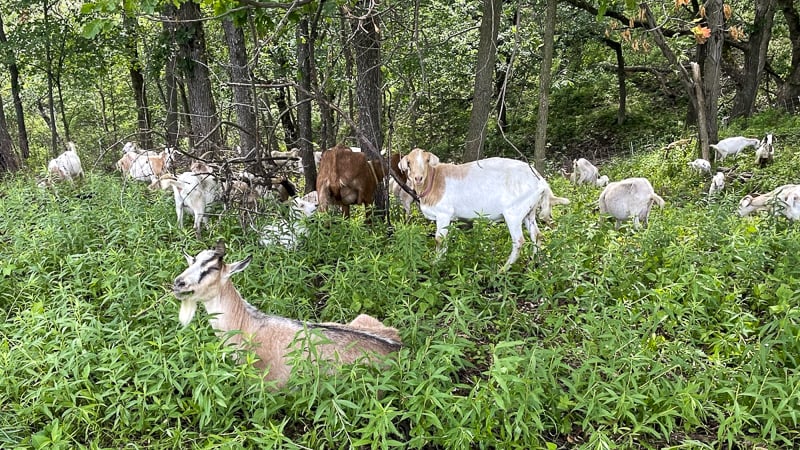
Birdnote(s): Literally!
By Janet Malotky, Minnesota Master Naturalist volunteer
A new kind of bird note is now making itself known down at the Sand Point Trail. Our fearless park leaders had the great idea of putting up informational signs about the birds visitors might find there, cross-referenced to season and habitat. The concept was further developed and designed by Jenni Webster of the Minnesota Department of Natural Resources, with input from Frontenac State Park Association members. The first signs were placed along the trail at the end of June.
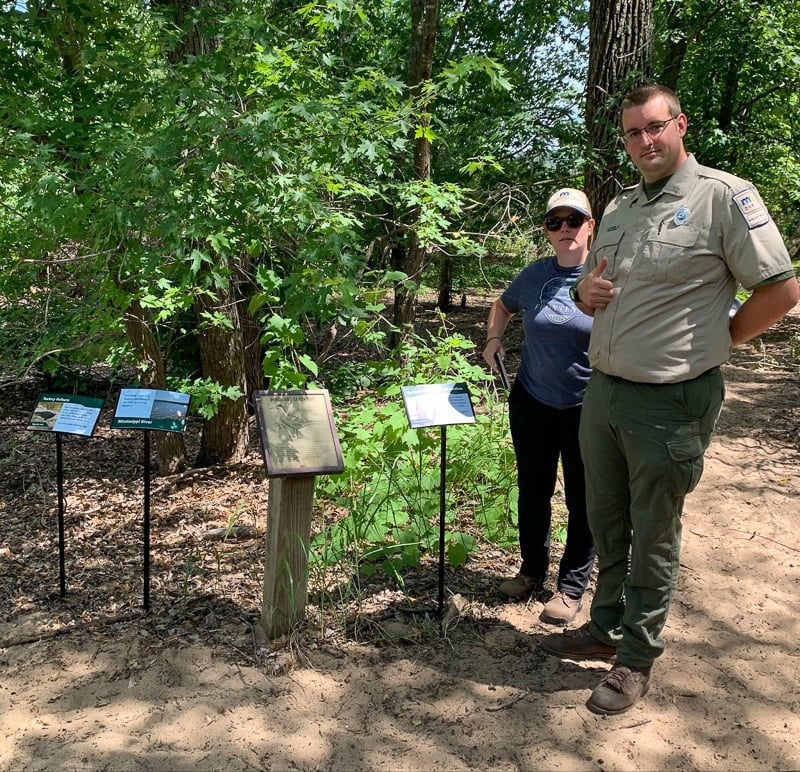
A key feature of our park is habitat diversity, and the Sand Point Trail has it in spades. It’s what makes the area so inviting for birds and such a great place to see a variety of bird species.
The start of the trail drops visitors into the cathedral of the riparian forest, a flood plain with towering trees, shrubby thickets, and a hodgepodge of fallen trees that provide shelter and nesting places for forest-loving birds. Upon reaching the bridge over the former Wells Creek riverbed, one encounters a series of seasonal wetlands that flood and dry out according to the water level of the nearby Mississippi River. Dabbling ducks can be found there when the water is high, shorebirds stalk the mud, and many little birds flit among the reeds.
Spilling out onto the beach, the trail confronts the mighty Mississippi, which is remarkably both a lake and a river at that point. It provides habitat for soaring fish and carrion-eating birds, huge flocks of migrating waterfowl, and the birds who eat insects on the wing, like swallows and martins. At rest along the shore can be found a variety of gulls and terns, pelicans, swans, shorebirds, kingfishers, and any bird who wants a drink. The diversity is truly amazing!
These four habitat types –- Floodplain Forest, Seasonal Wetlands, Near the Shore, and Mississippi River –- were selected by the park staff to organize the new trail signage. Although many bird species make use of these habitats, two species that are likely to be encountered will be highlighted for each season.
Thus, the summer floodplain forest birds include the Indigo Bunting and the American Redstart, two small, colorful species that nest in the forest and sing from the trees along the trail. The summer seasonal wetlands highlight the glowing Prothonotary Warbler and the secretive but noisy Marsh Wren. Near the shore, the summer stars include the Green Heron and the Belted Kingfisher. The summer Mississippi River birds are the Turkey Vulture and the Northern Rough-Winged Swallow. Use your Merlin app, if you’ve downloaded it, to preview these birds before your next Sand Point walk so you know who to look and listen for.
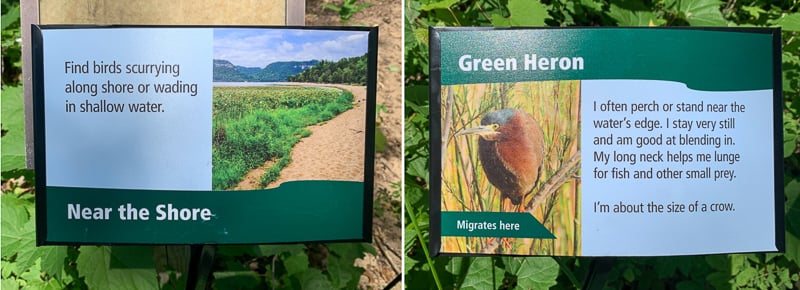
It’s key to remember that while birds are more likely to be found in their preferred habitat, they don’t read signs — and they can fly! Therefore, they also can be found in unexpected places, especially where differing habitat types are close together or overlap, as they do in the Sand Point area. But an attempt was made to place the signs along the trail where the focus birds have frequently been seen and heard in the past, so when you’re walking the trail, keep your eyes keen and your ears perked. Happy noticing!
Notes from the field: Flutter bye bye?
By Steve Dietz, Minnesota Master Naturalist volunteer
July is the high season for prairie plants and those that live off them, such as butterflies — “the charismatic fauna of the insect world.” A recent study published in Science, State of the Butterflies in the United States, estimates that in the part of the country containing Frontenac State Park, there may be 115 species of butterflies! And yet, in the FSP iNaturalist project, only 43 species have been recorded. So many still to see! And sadly, increasingly little time to see them …
One disturbing conclusion of the aforementioned study is that from 2000 to 2020 — just two decades — “the overall abundance of butterflies in the contiguous United States fell by more than one-fifth. . . . More than 70% of the assessed butterfly species suffered declines, with, alarmingly, over 140 species dropping by more than a half.”

The causes of this decline, broadly speaking, are not really a surprise: habitat loss, pesticide use and climate change. Countering the decline requires environmentally sound policies, of course, which is only one reason why it is so important to maintain natural areas like Frontenac State Park and not sell them off to the highest bidder.
About insecticides, the report writes:
“The shift away from organophosphate and carbamate insecticides to neonicotinoids and pyrethroids has meant while the quantity of insecticides (measured as pounds of active ingredients) applied to agricultural land has decreased in the past three decades, the toxicity loading of the environment for insects has increased. … While over half of insecticide use is in agriculture, insecticides are commonly used in residential and municipal landscapes, where they can contaminate flowering plants visited by butterflies; about a quarter of insecticide use is around homes and gardens.”
As Collin Edwards, the lead author of the study, put it: “If you’re spraying something on your plants to keep things from eating them, caterpillars are eating plants. Those are butterflies-to-be.”
The good news is that we can each do something that will actually help, no matter the scale, “by adding flowering plants (native plants are preferred), restoring host plants for butterfly caterpillars, minimizing or eliminating pesticides (especially insecticides), and leaving space for butterflies and their caterpillars to overwinter, pupate and seek refuge during inclement weather.”
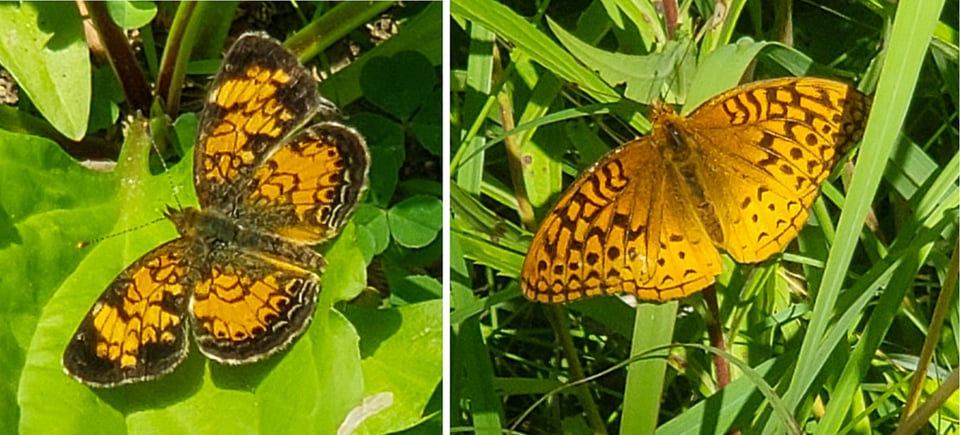
Correction: Last month, discussing how to begin to identify lichen, I wrote that “generally, foliose are yellow, fruticose green and crustose orange.” Wrong! Color is an important indicator, but I should have written that common lichen colors include yellow-green, blue-gray, black and white, and even orange, yellow and red. When wet, most lichen change colors, often dramatically.
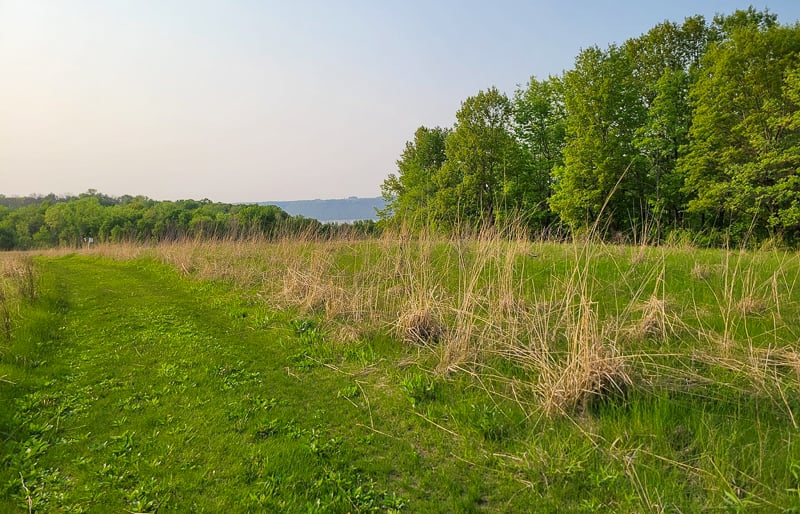
Nature books for summer reading
We like to think of summer as a time to be outside camping, hiking, swimming, fishing, boating. But don’t rule out long, languid summer days – especially when the heat and humidity ramp up – when lolling in a hammock with a good book is just the thing. Here are three absorbing new books about the natural world to check out this summer:

“Sea of Grass: The Conquest, Ruin, and Redemption of Nature on the American Prairie” by Dave Hage and Josephine Marcotty, 2025, Random House, 377 pages. A sweeping story about the ongoing destruction of American grasslands, wetlands and prairie, and what can be done to slow it. An eloquent study by two retired Minnesota Star Tribune journalists. We’re excited to report that Dave and Josephine will lead a prairie walk in our park on Sept. 6; watch for details in upcoming newsletters.
“Is a River Alive?” by Robert MacFarlane, 2025, Norton, W.W. & Co., Inc., 384 pages. Fueled by sound science and a sophisticated mysticism, the great British nature writer dives into the beauty and importance of rivers. A picnic table near the Frontenac State Park Mississippi overlook is the perfect place to read this one.
“Shelter and Storm: At Home in the Driftless” by Tamara Dean, 2025, University of Minnesota Press, 216 pages. “Dreams of the pastoral life have been drawn for ages, memorably by Thoreau and his experiment at Walden Pond,” wrote Star Tribune reviewer Michiela Thuman. “Yet we never seem to tire of such dreams or dreamers. At a time when our world feels chaotic and a bit upside down, it was grounding and meditative to follow one woman’s back-to-the-land adventure” in the Driftless area of southwestern Wisconsin, across the river from Frontenac State Park.
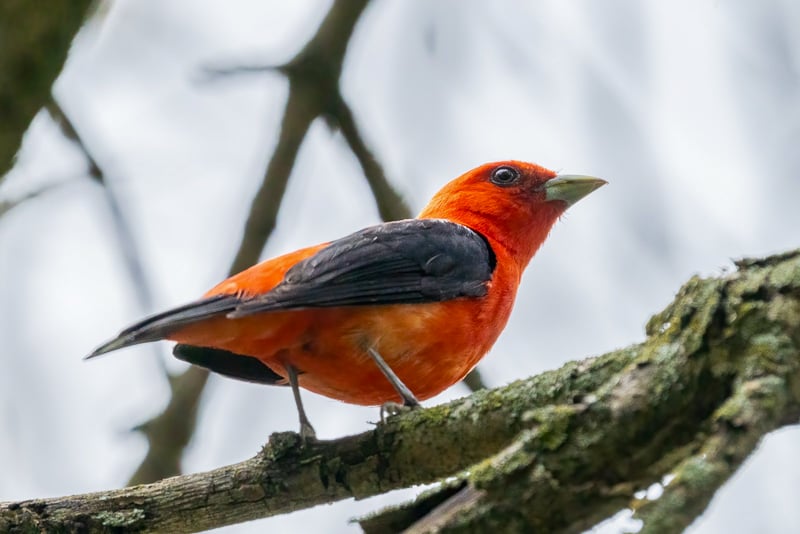
A bug we don’t much mind: Mayflies
By Pamela Miller, Minnesota Master Naturalist volunteer
(Note: This is an updated version of an article we published two years ago. Mayflies, like most natural phenomena, are an annual happening, so you might occasionally see an article from two or three years ago repurposed for a fresh newsletter. Don’t tell anyone!)
They descend on us after sudden, massive hatches – delicate insects that thicken the air and trees near Lake Pepin, black out the lights at Kwik Trips, slick up the bridges over the Mississippi, mess up your car, and get tangled in your window screens and your fancy hairdo.
Eek! Or, perhaps … hooray!
Mayflies, whose lyrical scientific name, Ephemeroptera or Ephemerida, reflects the fact that they don’t live long, are vital to the aquatic food web and a welcome indication of relatively clean water. (We’re not sure why they’re called mayflies, though, since we see them mostly in July and August.)
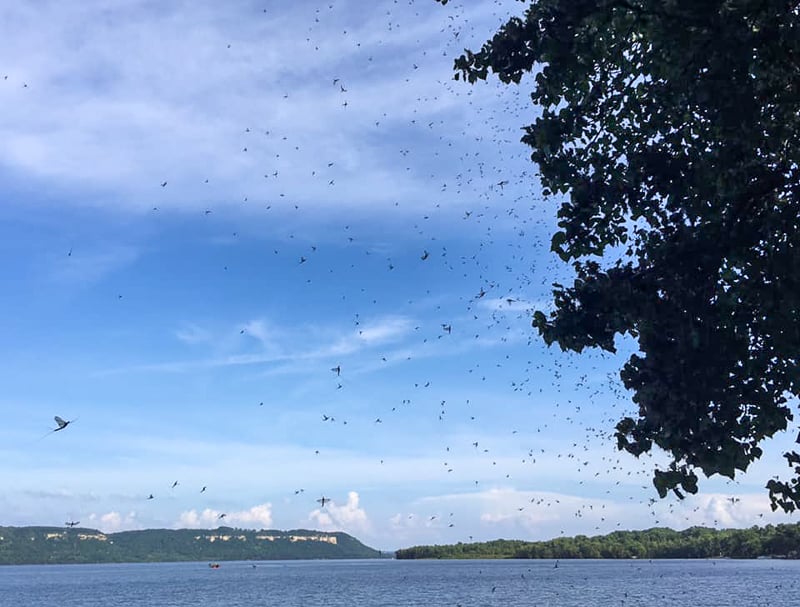
Here are some things to know about mayflies, thanks to the Minnesota DNR’s impressive species profile:
Reproduction: It’s sex, then death. Mating takes place in flight, as females fly through a swarm of males. They then lay eggs in the water and die.
What mayflies eat: Algae, fungi and decaying material (more reason to appreciate them).
What eats mayflies: Apparently, mayflies are delicious, though we’ll resist the mischievous urge to include mayfly recipes here. Amphibians, reptiles, fish, birds and mammals eat the nymphs. Birds and bats nab the fluttering adults. And when the mayflies die in huge swarms atop lakes and rivers, they present a bird and fish buffet.
Habitat: Mayflies need fresh water with healthy oxygen levels. This is why we’re happy to see them – they reflect the fact that the water is clean. Back in the 1960s and 1970s, when your newsletter editor was growing up in Old Frontenac, there weren’t many mayflies.
Here’s why, the DNR tells us:
"The mayfly is sensitive to chemical pollutants, increases in suspended solids (erosion) and decreased dissolved oxygen levels. The primary cause of the collapse of mayfly populations during the late 1960s, 1970s and early 1980s was sewage. Little or no treatment of sewage was occurring during this time. We were literally flushing our toilets into the river. There were reports from this period of ‘cakes of fecal matter’ floating on rivers.
"While this sounds bad enough, the problem for the mayflies wasn’t the poop itself, but what happened next. As bacteria began to break down this mass of organic sludge, they used up tremendous amounts of dissolved oxygen. They used up so much that mayflies, stoneflies, caddisflies and even fish disappeared from the Mississippi River from the Twin Cities all the way down to Lake Pepin.
"Today, because of modern sewage treatment facilities and regulations on the disposal of toxic chemicals, mayflies have returned to most of our waterways. New challenges revolve around chemicals that come from our homes and yards. Medications and other pharmaceuticals that leave our bodies go right through the sewage plants untreated and are affecting aquatic life that eat and breathe these compounds."
So, when you see mayflies, salute rather than swat them! And don’t worry – they don’t bite!
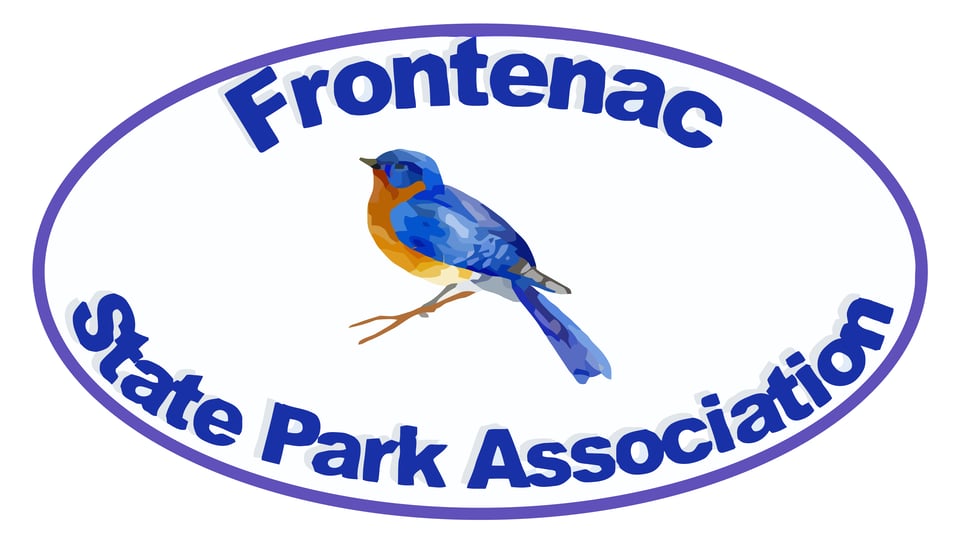
Bluebirds of happiness (aren’t they all?)
Just when we decide that wise friend of Frontenac State Park Bruce Ause can’t possibly write a post in his nature blog more interesting than the last, he … does. This one is about all things bluebirds and features Bruce’s beautiful photos. Here’s an excerpt from it that taught us something new:
… Once the bluebird eggs hatch, the nestlings will grow and develop for the next 17 to 21 days. A volunteer at Frontenac State Park [that would be our own Wally Siewert] recently reported 27 fully developed nestlings dead in seven different nest boxes. It is thought these birds were killed by buffalo gnats attracted by carbon dioxide escaping from the nest box. Some folks have reduced that threat by spraying vanilla into the box to mask the CO2. … [Bruce also told your newsletter editor that vanilla-scented car air fresheners can do the trick, too.]
More about the use of vanilla is on the Bluebird Society website here. We are finding that weather may also be a factor in increased bluebird mortality.
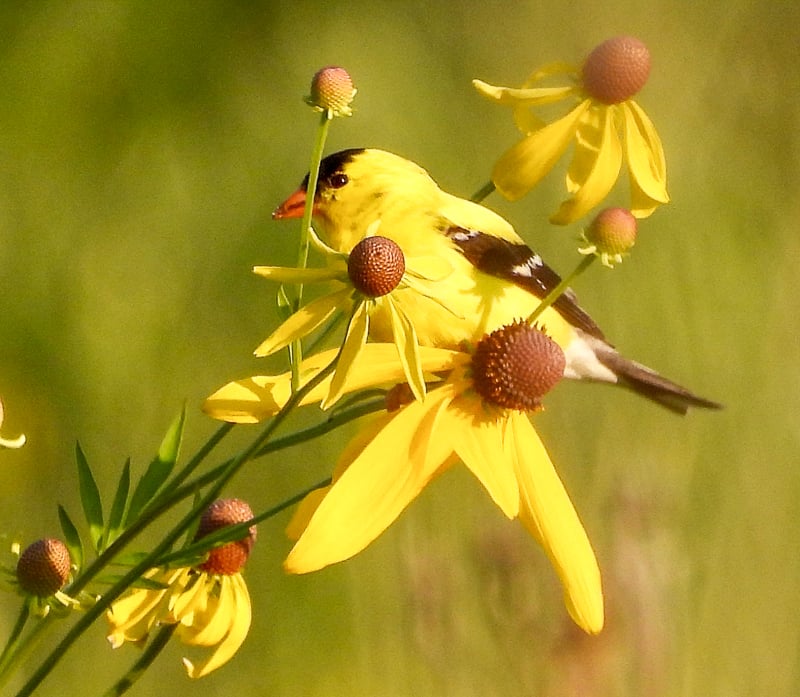
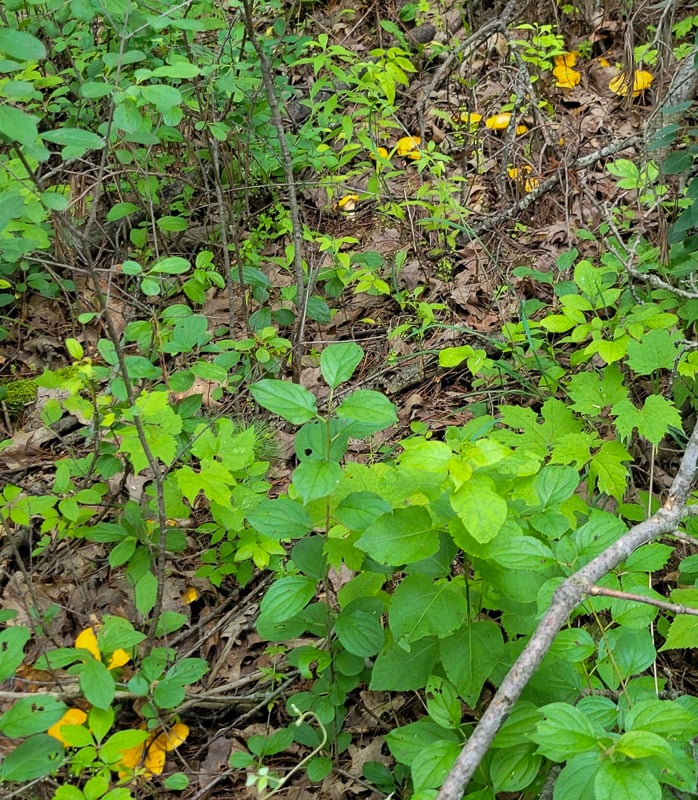
A path you’ll want to walk
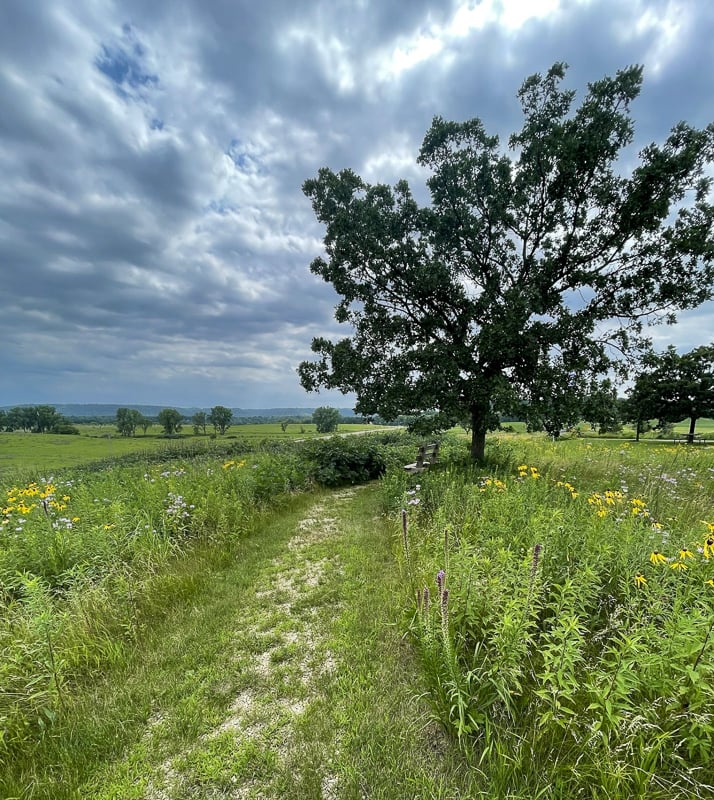
One of Frontenac State Park’s lesser-known gems, especially for hikers with nature-loving children, is a short guided prairie trail behind park headquarters. Back in 2016, park workers decided they wanted a no-mow interpretive area there, prepped it by burning, then seeded it. Over the years, Eagle Scouts and other volunteers have improved it by installing gravel, redoing the weed barrier fabric, pulling weeds, and adding signage about plants.
Now, park assistant manager Amy Jay tells us, it’s time for another sprucing-up as fast-growing sumac and sprawling bird’s-foot trefoil invade the area. New plantings and signs will be added. And volunteers are always welcome to help with this project.
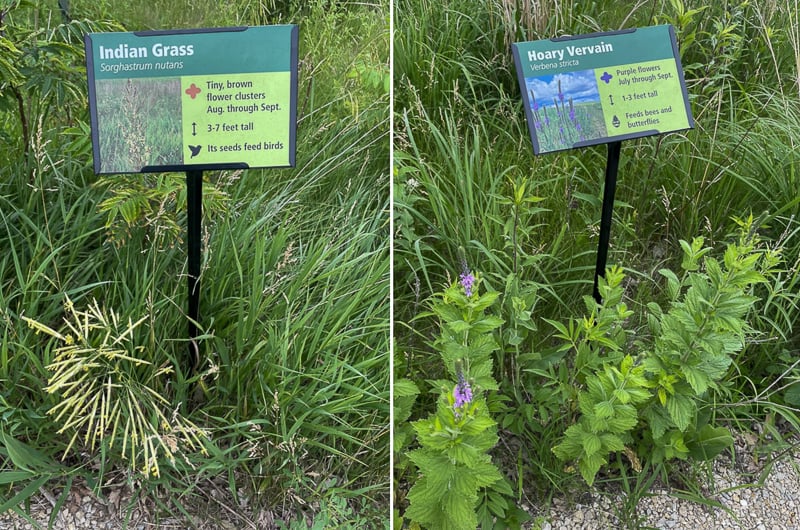
Poem of the month
“LEAVES COMPARED WITH FLOWERS”
By Robert Frost (American; 1874-1963)
A tree's leaves may be ever so good,
So may its bar, so may its wood;
But unless you put the right thing to its root
It never will show much flower or fruit.
But I may be one who does not care
Ever to have tree bloom or bear.
Leaves for smooth and bark for rough,
Leaves and bark may be tree enough.
Some giant trees have bloom so small
They might as well have none at all.
Late in life I have come on fern.
Now lichens are due to have their turn.
I bade men tell me which in brief,
Which is fairer, flower or leaf.
They did not have the wit to say,
Leaves by night and flowers by day.
Leaves and bar, leaves and bark,
To lean against and hear in the dark.
Petals I may have once pursued.
Leaves are all my darker mood.
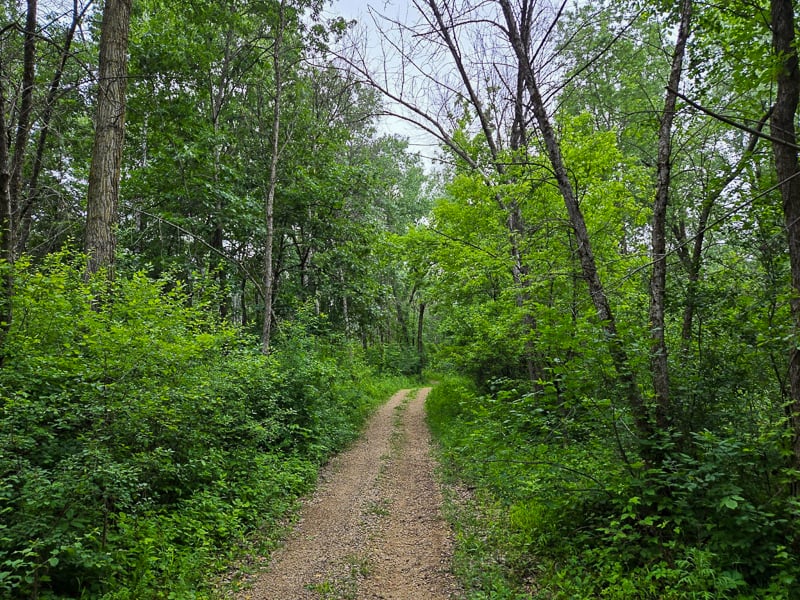
Interested in joining the FSPA?
If you are a member, thank you! You help us pursue our mission of supporting this treasured park in myriad ways.
If you’d like to join us, we’d be honored to have your support. Dues are $25 per year for an individual, $35 for dual/family membership. Here’s a link with signup information.
A reminder that joining us occasionally to help with volunteer efforts is awesome too, even if you’re not a member. The FSPA’s goals are to support Frontenac State Park activities and share our love of this beautiful park with as many people as possible.
To sign up to regularly receive this free, spam-free monthly newsletter, click on “Subscribe” below. Feel free to send questions or comments to your newsletter editor at pamelamarianmiller@gmail.com. Questions about the FSPA? You can reach hard-working FSPA chair Steve Dietz at stevedietz@duck.com.
Handy links for more information and education
Frontenac State Park
Frontenac State Park Association
If you take pictures in the park, tag us on Instagram
Frontenac State Park bird checklist
Frontenac State Park on iNaturalist
Parks & Trails Council of Minnesota
Website for our township, Florence Township
Minnesota Master Naturalist programs
Red Wing Environmental Learning Center
Lake City Environmental Learning Program on FB
Visit Lake City
Zumbro Valley Audubon Society
Bruce Ause’s Wacouta Nature Notes blog
Marge Loch-Wouters’ Hiking the Driftless Trails blog
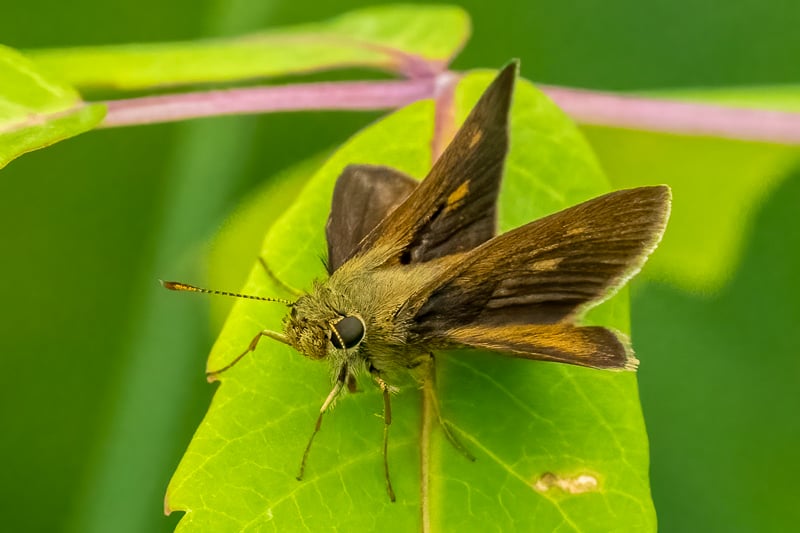
Frontenac State Park staff
Jake Gaster, park manager; Amy Jay, assistant park manager; Amy Poss, lead field worker
Parting shots
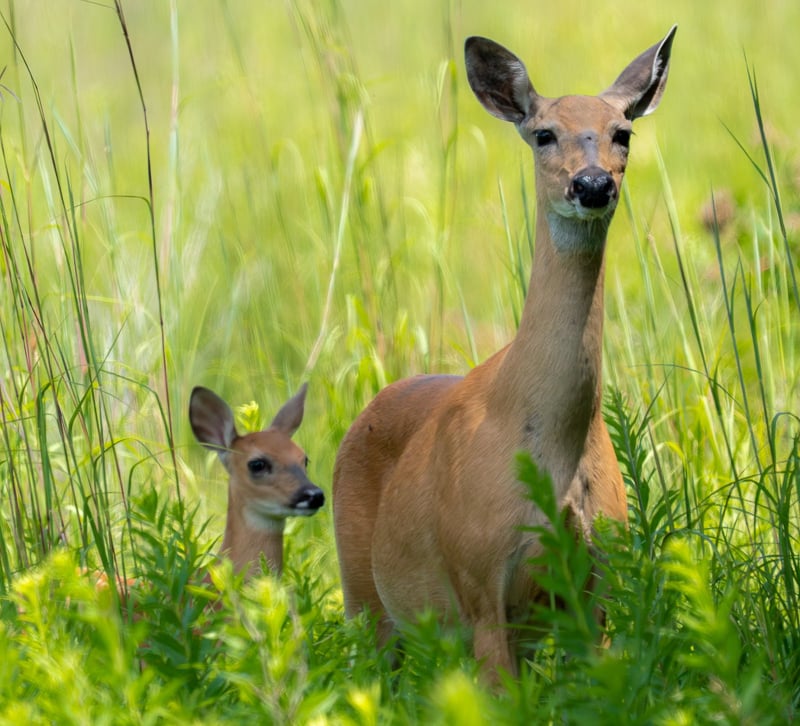
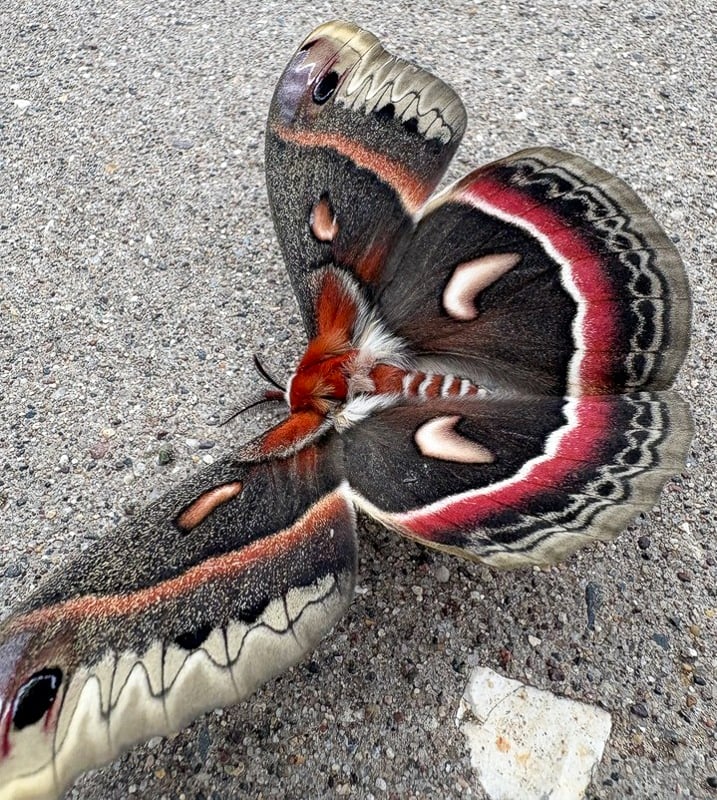

Thank you, readers and park visitors!
This is Volume 3, No. 7 of the Frontenac State Park Association newsletter, which was launched in April 2023.
Here’s where to browse the full archives of this newsletter.